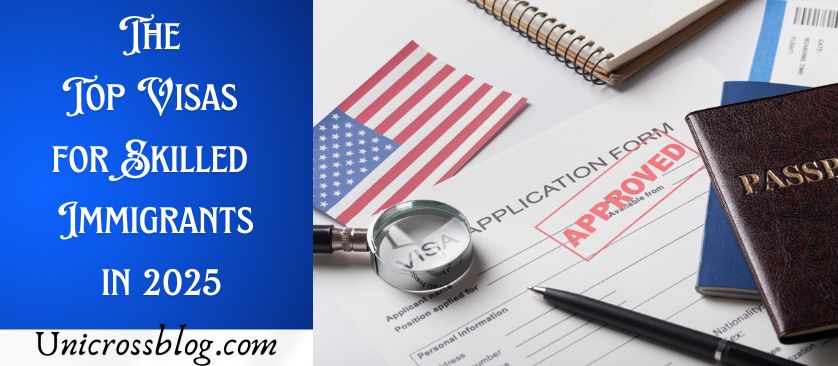As the global demand for skilled professionals continues to grow, countries worldwide are adapting their immigration policies to attract top talent. In 2025, numerous visa programs cater specifically to skilled immigrants, offering pathways for work, residency, and even citizenship. Below, we explore some of the most prominent visa options for skilled workers in key regions like the United States, Canada, Europe, Australia, and Asia, along with their unique features and requirements.

The Top Visas for Skilled Immigrants in 2025
United States: H-1B and O-1 Visas
1. H-1B Visa: Temporary Work Visa for Skilled Professionals
The H-1B visa remains one of the most sought-after options for skilled workers in fields such as technology, engineering, and healthcare. This visa allows employers to sponsor foreign workers for specialized roles requiring a bachelor’s degree or higher.
Key Features:
- Valid for three years, extendable to six.
- Dual intent, allowing holders to apply for a green card.
- Subject to an annual cap of 85,000 visas (20,000 reserved for advanced degree holders in the U.S.).
2. O-1 Visa: Extraordinary Ability Visa
The O-1 visa targets individuals with extraordinary ability in fields such as sciences, arts, education, business, or athletics.
Key Features:
- No annual cap, offering more flexibility compared to H-1B.
- Requires evidence of significant achievements, such as publications, awards, or high salaries.
- Typically granted for one to three years, renewable as needed.
Canada: Express Entry and Global Talent Stream
1. Express Entry Program
Canada’s Express Entry system is a point-based immigration program that evaluates candidates based on factors like age, education, work experience, and language skills.
Key Features:
- Covers three major pathways: Federal Skilled Worker Program (FSWP), Federal Skilled Trades Program (FSTP), and Canadian Experience Class (CEC).
- Offers permanent residency directly, with processing times often under six months.
2. Global Talent Stream (GTS)
The GTS is designed for employers to hire highly skilled foreign workers quickly.
Key Features:
- Fast-tracked work permit processing (usually within two weeks).
- Focuses on high-growth sectors, including AI, cybersecurity, and software development.
Europe: EU Blue Card and the UK’s Skilled Worker Visa
1. EU Blue Card
The EU Blue Card is a residence and work permit for non-EU citizens with high qualifications.
Key Features:
- Requires a job offer with a salary above a set threshold.
- Valid across most EU countries, except Denmark and Ireland.
- Offers the possibility of applying for permanent residency after 33 months (or 21 months with language proficiency).
2. UK Skilled Worker Visa
Post-Brexit, the UK’s Skilled Worker Visa has become the primary route for skilled immigrants.
Key Features:
- Requires sponsorship from a UK employer.
- Covers professions on the Shortage Occupation List, such as nurses, IT specialists, and engineers.
- Pathway to settlement after five years.
Australia: Skilled Migration Programs
1. General Skilled Migration (GSM)
Australia’s GSM program includes visas like the Skilled Independent Visa (subclass 189) and the Skilled Nominated Visa (subclass 190).
Key Features:
- Point-based system assessing factors such as age, education, work experience, and English proficiency.
- Direct pathway to permanent residency.
2. Global Talent Visa
Designed for highly skilled professionals in future-focused industries like fintech, medtech, and space technology.
Key Features:
- Fast-tracked application process.
- Offers permanent residency upon approval.
Asia: Japan and Singapore
1. Japan: Highly Skilled Professional Visa
Japan is actively seeking skilled workers to address its aging population and labor shortages.
Key Features:
- Point-based system prioritizing advanced degrees, work experience, and language skills.
- Offers long-term residency, with eligibility for permanent residency after one to three years.
2. Singapore: Employment Pass (EP)
Singapore’s EP is ideal for professionals in industries like finance, IT, and biotechnology.
Key Features:
- Requires a minimum monthly salary (raised to SGD 5,500 in 2025).
- Pathway to permanent residency through schemes like the Professional Conversion Programme.
Middle East: UAE Golden Visa
The UAE’s Golden Visa program has emerged as a top choice for skilled professionals seeking long-term residency.
Key Features:
- Targets professionals in sectors like healthcare, technology, and education.
- Valid for up to 10 years, with no sponsorship requirement.
- Includes family members, offering a stable and secure living environment.
READ ALSO: The 10 Best Jobs in AI and Machine Learning
FAQs
What is the easiest visa to obtain for skilled workers in 2025?
The “easiest” visa depends on your qualifications, industry, and destination. For example:
- Canada’s Express Entry favors individuals with high language proficiency and work experience.
- The UAE Golden Visa has relatively lenient criteria for skilled professionals compared to Western countries.
Can I bring my family on these visas?
Most skilled visas, such as the H-1B, EU Blue Card, and Canada’s Express Entry, allow family members to accompany you. Family members often receive dependent visas with work and study rights.
How do point-based systems work?
Point-based systems (e.g., Canada’s Express Entry, Australia’s GSM) evaluate applicants based on factors like age, education, work experience, and language skills. Higher scores improve your chances of receiving an invitation to apply for a visa.
Are there specific age limits for skilled immigration?
Many point-based systems prioritize younger applicants (typically under 45), but exceptions exist for individuals with exceptional skills or sponsorships.
Can skilled visa holders apply for permanent residency or citizenship?
Yes, most skilled visas offer pathways to permanent residency. For instance:
- H-1B visa holders in the U.S. can transition to green cards.
- EU Blue Card holders can apply for permanent residency after a few years.
What industries are in high demand globally?
In 2025, industries such as technology (AI, software development), healthcare (nursing, doctors), and green energy are experiencing the highest demand across most countries.
How long does it take to process skilled visa applications?
Processing times vary:
- Canada’s Express Entry takes around six months.
- Australia’s Global Talent Visa can be approved in weeks.
- EU Blue Card processing times depend on the country but average two to four months.
Do I need a job offer to apply?
While some visas (e.g., H-1B, Skilled Worker Visa) require a job offer, others, like Canada’s Express Entry or Australia’s Skilled Independent Visa, do not necessarily require one.
Conclusion
In 2025, opportunities for skilled immigrants are abundant, with countries vying to attract top talent through flexible, streamlined, and beneficial visa programs. Understanding each visa’s requirements and benefits is crucial for making an informed decision. Skilled professionals should assess their qualifications, target industry, and desired lifestyle to choose the best immigration pathway.







